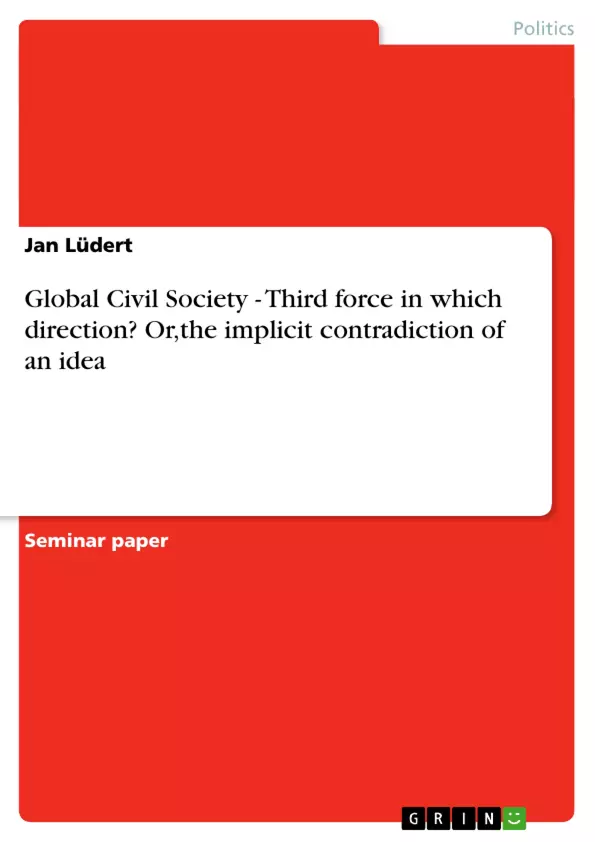When looking at a ‘black and white picture’ one rarely realizes, without closer
inspection, that hardly any pure black or white can be found on the emulsion. Rather
varied degrees of grey give the picture its contours on a two-dimensional medium. The conventional term is as Aristotle’s manifested in the law of contradiction,
widersprüchlich. The idea of a ‘global civil society’ (GCS) does not differ from the
observable contradiction between concept and fact of B/W photography. The widely
accepted conceptualisation of GCS as the following argument will show, might be useful as an analytical tool; it does however obscure implicit contradictions of the idea itself. Its terminology, it is argued, can be a reductio ad absurdum if not cautiously used and reflected upon in any given context.
As a neologism, Keane observers, GCS is ‘becoming fashionable’ continuing to justify its conceptual usage ‘as an ideal type, for heuristic purposes’. Whilst dismissing its western origins ‘and the possibility that it imposes alien values’ as irrelevant consideration. Keane not alone in his reduction and in his benign outlook of the ideal type, treads on a swampy path when he goes on to see ‘invisible governance’ as an example of civil society outside its western original in the Batswanan kgotla system of chieftain domination. Without aiming to dismiss the recent achievements of actors in GCS, the aforementioned example of the kgotla highlights how actors of civil societies function ‘within inherited structures of power that they may modify or alter but seldom transform’.5 Thus as this paper will illustrate the fallacy of ‘contemporary thinking’, which as Chandhokes shows ‘gives us a picture of a global civil society that seems to be supremely uncontaminated by either the state or that of markets’.6 In other words the grey notion of GCS cannot be conceptualized without the black of the market and the white of the state [or vice versa].[...]
Inhaltsverzeichnis (Table of Contents)
- The Implicit Contradictions of an Idea
- The History of Civil Society
- Civil Society and the State
- Global Civil Society
- Contradictions and Contestations
Zielsetzung und Themenschwerpunkte (Objectives and Key Themes)
This paper aims to analyze the concept of Global Civil Society (GCS), examining its historical development, inherent contradictions, and role in contemporary political and economic structures. It explores the relationship between GCS, the state, and the market, highlighting the ongoing debate surrounding the nature and influence of non-state actors in a globalized world.
- The historical development of the concept of civil society
- The inherent contradictions and ambiguities within the concept of GCS
- The relationship between GCS, the state, and the market
- The role of non-state actors in shaping global governance
- The contestation and debate surrounding the concept of GCS
Zusammenfassung der Kapitel (Chapter Summaries)
The first part of the paper delves into the history of civil society, exploring its evolution from its western roots to its contemporary conceptualization. It examines how scholars have debated the relationship between civil society and the state, particularly in the context of state and capitalist power structures.
The second part of the paper focuses on the ongoing debate surrounding civil society, highlighting the contradictory views of neoliberals and radical thinkers. It examines how contemporary conceptions of GCS grapple with the complex interplay of state, market, and civil society.
Schlüsselwörter (Keywords)
Global civil society, civil society, state, market, non-state actors, governance, globalization, neoliberalism, radicalism, western origins, historical development, contradictions, contestations, post-westphalian, neo-medieval, kgotla system.
- Citation du texte
- Jan Lüdert (Auteur), 2007, Global Civil Society - Third force in which direction? Or,the implicit contradiction of an idea, Munich, GRIN Verlag, https://www.grin.com/document/88481



